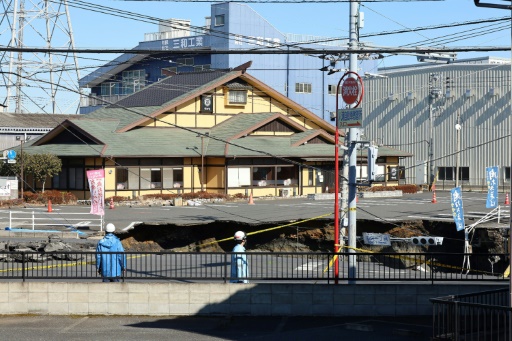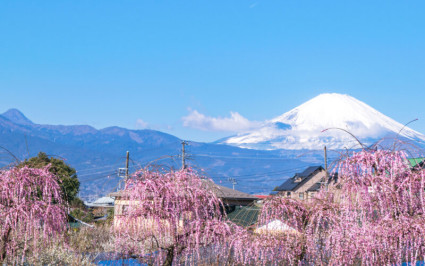A massive sinkhole in Saitama Prefecture that swallowed a truck and its driver a week ago, and has filled with sewage and debris, highlights the risk posed by Japan's aging pipes.
Emergency workers have been striving in vain to reach the 74-year-old man, who rescuers have had no contact with for a week, and who was likely buried under sediment and sewage water in the sinkhole in the city of Yashio.
Officials say corroded sewerage pipes created the sinkhole that is now 40 meters wide -- nearly the size of an Olympic swimming pool -- and 15 meters deep.
Cranes have been mobilized and a 30-meter slope built to locate and reach the driver, with a second slope under construction, but progress has been slow and dangerous.
Koichi Yamamoto, an official with Yashio's fire department, told AFP on Tuesday that rescue efforts had been suspended.
A "substantial" amount of sewage water has accumulated at the site, eroding the surrounding soil and "constantly flowing in like a river", he said. "This makes it impossible for us to proceed."
Also "hampering our rescue operation is a pile-up of heavy masses such as debris, slabs of asphalt and concrete that need removing", Yamamoto added.
When the hole suddenly opened up in Yashio during the morning rush hour on Tuesday last week, it at first looked like just one of thousands of sinkholes reported annually across Japan.
Their occurrence is trending upwards in Japan, topping 10,000 in fiscal 2022, with many of the sinkholes sewage-related in urban areas, a land ministry probe shows.
Initially the hole was around five meters in diameter, then a much larger cavity opened nearby and the two holes merged.
To reduce the volume of sewage, locals were urged to "use as little water as possible" for three hours on Tuesday afternoon.
This was on top of requests already issued for about 1.2 million people in Saitama to refrain from non-essential use of water, such as taking baths or doing laundry.
In response, some onsen have opened their public bath facilities for free to accommodate residents in Yashio and nearby areas, according to local media.
The week-long sinkhole saga was a reminder of the insidious corrosion gnawing at Japan's aging water and sewerage pipes, Shinya Inazumi, a professor of geotechnical engineering at Shibaura Institute of Technology, told AFP.
The majority of the underground infrastructure was developed during the country's rapid postwar economic growth.
"Many sewerage pipes in Japan have already outlived their service life (of 50 years) so pipes anywhere else could break due to aging," Inazumi said.
In just over 15 years' time, 40 percent of Japan's sewerage pipes will have exceeded their lifespan, according to an estimate from the land ministry.
In Yashio, local authorities attributed the initial chasm to rusty, punctured sewerage pipes that absorbed the surrounding soil, creating a hollow under the ground.
Extreme weather events such as intense rain can also exacerbate this kind of infrastructure failure, Inazumi said.
"Rainfall these days can be extremely heavy and localized, which means a great amount of water seeps underground," the professor said. "The water gushes in at an incredible speed, accelerating the growth of an underground hollow by making it bigger and bigger through erosion."
© 2025 AFP















21 Comments
Login to comment
diagonalslip
severe as this is, I think it's the tip of the proverbial, as infrastructure of all sorts, everywhere, reaches or passes its use-by date.....
justasking
So we're just going to treat the old guy as some statistics? No compassion or empathy?
Aaron Wright
It also highlights the risk of poor construction, poor oversight, and poor rescue plans.
TaiwanIsNotChina
What a sad situation. Have they tried just winching the darn truck out of there?
kurisupisu
.
Unfortunately, the truck must have been buried under tons of effluent as there is no way millions of people would suddenly just stop using their lavatories.
Marc Lowe
After reading this shocking and sad report, I can;t help but think that not enough has been done in the rescue effort. The JSDF probably could have extracted the man in minutes. Couldn't some local contractor have used an electromagnet crane? And, regarding the sinkhole, all they need to do is create air vortexes to send thru the pipes to make sure they don't collapse further. There are videos on YouTube that show how to make DIY air vortex cannons. With all these resources unused it seems such a shame. Still hoping for a miracle. The poor driver must be terrified down there.
The_Beagle
Are we to take this as subterranean rivers of sewage could swallow up anyone anywhere at anytime?
151E
Perhaps local or prefectural governments could periodically go out and use ground penetrating radar to survey roads and identify possible sinkholes before they collapse.
quercetum
When they were having a meeting and speaking one by one, the window for rescue closed.
Ambulances in Japan saunter politely across the city and take their sweet old time.
dan
Billions of dollars for American missiles but no funds for replacing old pipes!
Smh.
wallace
The old brick-built sewer tunnels need replacing and repairs.
SomeWeeb
Perhaps people should be building things so that they can be accessed and repaired rather than just burying them and hoping for the best?
Cephus
As saddening as this story is, it also serves to remind as we need better disaster management strategies. The loss of this senior citizen should not be in vain but a reminder of our shortcomings especially when dealing with old infrastructures.
Zaphod
Fixing THAT is something tax payers money should go to, instead of vanity projects and supporting American proxy wars.
Zaphod
151E
I actually came across one in Tokyo the other day, in the Musashikoyama area. Not as massive as the one in Saitama, and nobody fell in, but it could have been deadly for bike rider like me. Seems the problem is bigger than just Saitama.
wallace
The replacement of the old brick sewers would be a massive cost and disruption. There has to be a way to install new plastic pipes inside the old brick ones without digging up thousands of kilometers of roads.
grc
Aaron Wright - well said
nandakandamanda
Good article in the use of steel-reinforced sewage pipes which were popular post war as it says above. (Brick construction is not part of the present problem.) The problem in Japan is the corrosive sewer gases which attack the integrity of the concrete used.
Materials Used for Construction of Sewer | Sewage | Sanitary Engineering
(From www.engineeringnotes.com, for educational purposes.)
Quote: Now a days cement concrete is extensively used in the construction of sewer lines. These may be precast or cast in situ. Precast pipes are manufactured by centrifugal process using steel reinforcement, and are known as ‘Hume Pipes’. Hume pipes are manufactured in 10 cm to 250 cm in diameter and in 1.0 m to 3 m lengths.
These pipes are strong, smooth and light in weight. These are generally joined by collar joints. Plain concrete pipes may be used up to 60 cm diameter but above it the pipes must be reinforced. Precast pipes are manufactured in factories and are then transported to the site. The reinforcement of R.C.C. pipes consists of a welded steel cylinder or steel wire mesh.
Cement concrete pipes are not more durable and have short life, because they are corroded by sanitary sewage gases. These are most suitable for combined-sewer and storm water sewer, because in such cases its life is increased.
These pipes are subjected to corrosion where acid discharges are carried in the sewer or where the velocities are not sufficient to prevent the septic conditions or where the soil is highly acidic or contains excessive sulphates. Protective coatings should be used inside outside where excessive corrosion is likely to occur. Only high alumina cement concrete should be used when the sewer is exposed to corrosive sewage or industrial wastes.
owzer
Sadly, I think a week is more than even a young, healthy man could endure in those conditions. I have little hope for a rescue.
Aoi Azuuri
Its sewer pipe was broken despite within useful life.
on the other hand, Japan's LDP government restarts superannuated nuclear plants over useful life one after another.
iron man
ok, I am good for a few minutes on this. Brick transit sewers can be renovated by manual treatment whilst over-pumping between access chambers, but it is still a brick structure. ground is always moving, W.T, changing. cheaper to install a new liner and grout the annulus.
Sewers and storm waters (gravity) can be lined with a grp fibre whilst overpumping. tech around for decades now (relatively cheap), used inside the steel pipes. Water mains are shallow above the drains, and are pressure pipes, typically a M.D.P.E. liner. Very costly, all T-junctions need excavating for replacement. Water mains cause most wash out problems. Fresh water leakage costs millions $$$ rehab costs, amortize them. Some experienc there, sewers are stinky, deep to shallow sewerstormwaterutility inc gas. hope that bored you silly.